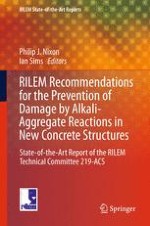This book contains the full set of RILEM Recommendations which have been produced to enable engineers, specifiers and testing houses to design and produce concrete which will not suffer damage arising from alkali reactions in the concrete. There are five recommended test methods for aggregates (designated AAR-1 to AAR-5), and an overall recommendation which describes how these should be used to enable a comprehensive aggregate assessment (AAR-0). Additionally, there are two Recommended International Specifications for concrete (AAR-7.1 & 7.2) and a Preliminary International Specification for dams and other hydro structures (AAR-7.3), which describe how the aggregate assessment can be combined with other measures in the design of the concrete to produce a concrete with a minimised risk of developing damage from alkali-aggregate reactions.
